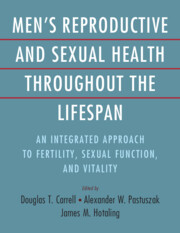 Men's Reproductive and Sexual Health Throughout the Lifespan
Men's Reproductive and Sexual Health Throughout the Lifespan from Section 2 - The Biology of Male Reproduction and Infertility
Published online by Cambridge University Press: 06 December 2023
Spermatogenesis is a complex process that ensures daily production of mature male gametes. The differentiation of spermatogonia stem cells into spermatozoa requires the unfolding of several events that are highly regulated in time and space. During spermatogenesis, which takes place inside the seminiferous tubules, germ cells undergo profound morphological rearrangement as can be observed by classical histological analysis of human testis specimens. Spermatogenesis also brings about the dramatic rearrangement of genetic makeover of developing germ cells including homologous recombination and changes in the epigenetic landscape. In this chapter the different phases of human spermatogenesis and cell types involved are described with an emphasis on their morphological arrangements. In parallel, an update on novel findings concerning the cycle of the seminiferous epithelium, the kinetic of spermatogonial compartment, and the implications of single-cell transcriptome analysis of testicular cells will be provided.
To save this book to your Kindle, first ensure [email protected] is added to your Approved Personal Document E-mail List under your Personal Document Settings on the Manage Your Content and Devices page of your Amazon account. Then enter the ‘name’ part of your Kindle email address below. Find out more about saving to your Kindle.
Note you can select to save to either the @free.kindle.com or @kindle.com variations. ‘@free.kindle.com’ emails are free but can only be saved to your device when it is connected to wi-fi. ‘@kindle.com’ emails can be delivered even when you are not connected to wi-fi, but note that service fees apply.
Find out more about the Kindle Personal Document Service.
To save content items to your account, please confirm that you agree to abide by our usage policies. If this is the first time you use this feature, you will be asked to authorise Cambridge Core to connect with your account. Find out more about saving content to Dropbox.
To save content items to your account, please confirm that you agree to abide by our usage policies. If this is the first time you use this feature, you will be asked to authorise Cambridge Core to connect with your account. Find out more about saving content to Google Drive.